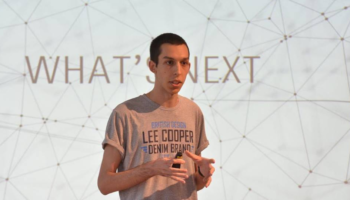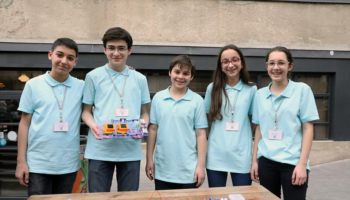There is the second city under Tbilisi. Its construction started from the 30s of the 20th century. In 1941, the Defense Committee of the State issued a secret order according to which the secret underground shelters were to be built for the purpose of evacuating the government.
Tunnels have acquired civil defense function over time. Today, most of the existing bunkers in Tbilisi are destroyed. They also say that the tunnel built on the initiative of Stalin and Lavrenti Beria can even stand atomic bomb. Its location is certainly not known. The underground part of the city is kept secret, so many people try to explore and see such places, they are called diggers.
“Doctrina” has interviewed one of the diggers Luka Japaridze.
– First of all, tell us about how long you have you been studying the underground part of the city? What is your goal?
We started working about 4 years ago. We were unified by one of the internet forums. Our team consists of four people and we do not yet think about expanding the group. As far as possible, we try to cross the Georgian borders and examine the underground places of other countries. For example, we were in Armenia recently, we visited Yerevan’s unfinished metro station “Ajapniak” and examined tunnels.
-As we know, construction of tunnels started from the 30s of the twentieth century. What purpose did they serve? It is known that they used the tunnels for civil defense, to protect from air bombing, etc. Do they have they the same feature currently?
According to our information, the first shelter was built in 1932 in Tbilisi. It is located under one of the school buildings in Tbilisi. But there is no conditions to take shelter there. We also have information that there are about 480 underground shelters in Tbilisi and only two are ready to receive part of the population during the war. Most of the shelters were destroyed or turned into warehouses.
– We know that the location of the objects is secret, but there are several places that are known to the public. Tell us about them.
For example, the underground shelter near Rustaveli metro, which is one of the most famous places in Tbilisi. As a rule, the younger diggers are starting to work from here. The most interesting thing is that the object is of a corridor system and does not have many room. The shelter has been robbed over the years some people misappropriated a certain part and rebult them as storerooms.
-Which object has impressed you, and why? Which expedition would you choose?
-It is really difficult to pick out any object, because when you find out any shelter and start to study it, it’s always something different, but in my subjective opinion, the only object that is different from all the others in terms of construction, number of rooms and function is the underground shelter located on the right shelter bank (of the river Mtkvari) . It is built in the cave. There are up to 100 rooms, and its main function was to give shelter to high-ranking officials during the war situation. It was equipped with a secret material room visitors were given special passes noting which room can they view.
– What is the benefit this area brings to the public?
– This field can bring great benefit to both the state and society. In many countries (for example, in Russia), a number of digers have been taken by security services under their control and they are involved in anti-terrorist operations. Also, this area can offer tourists urban tourism that is developed in many countries of Europe. It is possible to reconstruct objects into museums, hotels, casinos and other places where the state will have some income and the public will benefit from the renewed function of a certain object.
– How do you find similar objects?
– It’s a little difficult to explain. When you are new in this field and you know the structures, it is difficult to find something, but practice brings everything. It is enough to know what are the features of the underground object and how it is connected with the overground world, which objects were built with underground shelters and so on.
– And what about the threats?
– There is a lot of danger. Harmful substance may be ingaled or a ladder can be broken or so on. Many times I have had the cases of touching with asbestos, we have had to get rid of mercury several times, but we have not hinder our work.
– They say that many underground objects are being destroyed. Why? Have you asked anyeone for help? and what is the best way out of this difficult situation?
-They are being destroyed because of carelessness. When people were in need, radio equipment and other electrical equipment were brought from such facilities. When such valuable items were were not left, they started to sell scrap-iron. They removed the hermetic doors and almost everything that was made from metal. We have not asked for help, because they refused to open a museum at one of the objects and, therefore, we are past hope. The solution is that these places can be upgraded by another function. It is clear that most people will never be restored in the original form and can not actually fulfill the function, since these objects were designed at the level of development of that time’s devastating devices.
– What are you planning to do in this direction in the future?
We do not have a specific plan at this stage. We want to reconstruct one of the objects as a museum, where there will be stories on different objects, pictures, etc.
– There are many legends, tell us about one of them.
As for the legends, the most popular is the so-called Tbilisi Pentagram, which connects five different houses with each other, and therefore is a pentagram. There are also legends about the tunnel from one city to another. In general, we perceive them as unserious and we do not show any interest in the similar legends.
– Give advice to those who are interested in the underground city.
– I would like to advise those people, who are interested in the underground city, to start with an easy object, it will give them experience, to learn what do mercury and other dangerous materials look like, which are often found in underground objects. The most important thing is to evaluate their physical abilities, equipment and the complexity of the object.
Author: Nini Mshvenieridze
Translation: Tamar Tabatadze
The Hall of Young Scientists & Analysts – “Doctrina”







